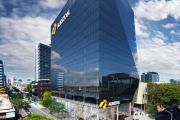
Pandemic speeds up structural shift in Brisbane's industrial supply chains
Industrial assets don’t often get much time in the metaphorical leasing sun, but that is set to change post-coronavirus crisis and especially for transport and logistics.
Experts agree that if the pandemic has shone a light on anything, it is that the lockdown has resulted in a rapid “structural shift” to e-commerce with its high need for storage space.
“The Brisbane industrial market is very well-placed to overcome the economic downturn caused by the pandemic,” Colliers Industrial national director Matthew Frazer-Ryan said.
“We continue to witness healthy levels of leasing demand and inquiries from transport and logistics companies, which are expanding operations to support the structural shift towards e-commerce.”
Increased demand for consumer goods during the crisis has also resulted in Queensland businesses reassessing their supply chain models, according to Cushman & Wakefield industrial national director Michael Callow.
He said businesses who had been late to the e-commerce party were now having to quickly lift their game.
“Those last to keep pace with the e-commerce boom in the fast-moving consumer goods market are being forced to rapidly adapt to the online ordering increases as a result of the COVID-19 pandemic,” Mr Callow said.
“Many operators are also rethinking their supply chain model, having accessible inventory in facilities designed for rapid delivery as well as holding more stock onshore.”
He said there could also be a spike in manufacturing activity within Australia because of the pandemic, with less manufacturing being sourced offshore.
JLL director and head of Queensland industrial Shaun Canniffe said the pandemic had reinforced the importance of sustainable and robust supply chains, particularly for critical goods.
He said the experience would ultimately benefit the transport and logistics sector.
“There have been some great learnings from these events,” Mr Canniffe said.
“There is no doubt that all sectors of industry – particularly transport and logistics – are putting in place strategic plans to ensure their supply chains are as strong as possible and protected against any possible disruption.
“This will ultimately generate strong activity within the industrial real estate market.”
JLL director of research Australia Bhavin Patel said the transportation sector was set for a big shake-up after struggling with supply during the crisis.
He said supply chains that formerly relied heavily on low-cost manufacturing hubs in Asia and China would have to be re-engineered post-pandemic.
“All industries will have to adapt post-COVID-19 by either diversifying their supply chains, which will be costly, or by having larger inventory buffers along the chain,” Mr Patel said.
“In either case, demand for industrial space will increase.”
While he said it was too early to understand the full impact of the crisis on the industrial sector, investor appetite for industrial assets would certainly increase.
Ray White head of commercial research Vanessa Rader said the Yatala industrial precinct had held its ground during the economic uncertainty, with leasing activity still occurring.
She said the precinct was well placed to ride out the current situation with recent leasing activity showing an increase of about 1.6 per cent in average net face rents compared with the second half of 2019.
“While there is uncertainty surrounding the current economic environment, we have continued to see leasing activity during the first four months of 2020 with some leases being negotiated over the troubled past month,” Ms Rader said.
Mr Frazer-Ryan said a recent leasing deal in Brisbane’s south-west industrial precinct that was a direct result of the crisis was a company that had secured an urgent medical supplies contract.
“Specialised Logistics Australia secured a 3PL contract to support growth in the medical supplies sector and promptly leased an existing 10,000-square-metre A-grade facility via a sublease opportunity,” he said.
“The critical driver was the quality of the facility and its improved functionality when compared to older-style warehouse facilities.”
The robust demand for Brisbane industrial spaces will help to underpin rents in the months ahead, Mr Frazer-Ryan said.
He said average prime-grade net face rents were likely to hold firm in the $111 per square metre range, with average net face rents for secondary grade to mostly hold steady at $81 per square metre.
However, leasing demand for some secondary assets may be patchy, he said.
“We anticipate … notably less demand for secondary grade accommodation where efficiencies are limited and a large portion of current vacancies exist, with secondary grade incentives metrics in some precincts reaching as high as 20 per cent, particularly in outer precincts like the south and south-west,” Mr Frazer-Ryan said.
Mr Callow said industrial precincts near residential areas were poised to benefit from increased demand and rental growth.
“Many transport and delivery operators need distribution hubs closer to residential pockets, and we expect this to become the norm coming out of the pandemic and potentially the repurposing of retail assets for distribution hubs,” he said.
“As such, fringe areas will be in higher demand and experience rental growth.”
While CBRE industrial and logistics senior director Peter Turnbull said areas with a positive outlook were all suburbs with quick access to distribution routes, including along the Logan Motorway and the south, south-west and TradeCoast precincts.










